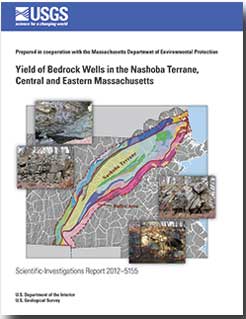 Abstract
Abstract
The yield of bedrock wells in the fractured-bedrock aquifers of the Nashoba terrane and surrounding area, central and eastern Massachusetts, was investigated with analyses of existing data. Reported well yield was compiled for 7,287 wells from Massachusetts Department of Environmental Protection and U.S. Geological Survey databases. Yield of these wells ranged from 0.04 to 625 gallons per minute. In a comparison with data from 103 supply wells, yield and specific capacity from aquifer tests were well correlated, indicating that reported well yield was a reasonable measure of aquifer characteristics in the study area.
Statistically significant relations were determined between well yield and a number of cultural and hydrogeologic factors. Cultural variables included intended water use, well depth, year of construction, and method of yield measurement. Bedrock geology, topography, surficial geology, and proximity to surface waters were statistically significant hydrogeologic factors. Yield of wells was higher in areas of granites, mafic intrusive rocks, and amphibolites than in areas of schists and gneisses or pelitic rocks; higher in valleys and low-slope areas than on hills, ridges, or high slopes; higher in areas overlain by stratified glacial deposits than in areas overlain by till; and higher in close proximity to streams, ponds, and wetlands than at greater distances from these surface-water features. Proximity to mapped faults and to lineaments from aerial photographs also were related to well yield by some measures in three quadrangles in the study area. Although the statistical significance of these relations was high, their predictive power was low, and these relations explained little of the variability in the well-yield data.
Similar results were determined from a multivariate regression analysis. Multivariate regression models for the Nashoba terrane and for a three-quadrangle subarea included, as significant variables, many of the cultural and hydrogeologic factors that were individually related to well yield, in ways that are consistent with conceptual understanding of their effects, but the models explained only 21 percent (regional model for the entire terrane) and 30 percent (quadrangle model) of the overall variance in yield. Moreover, most of the explained variance was due to well characteristics rather than hydrogeologic factors. Hydrogeologic factors such as topography and geology are likely important. However, the overall high variability in the well-yield data, which results from the high variability in aquifer hydraulic properties as well as from limitations of the dataset, would make it difficult to use hydrogeologic factors to predict well yield in the study area.
Geostatistical analysis (variograms), on the other hand, indicated that, although highly variable, the well-yield data are spatially correlated. The spatial continuity appears greater in the northeast-southwest direction and less in the southeast-northwest direction, directions that are parallel and perpendicular, respectively, to the regional geologic structural trends. Geostatistical analysis (kriging), used to estimate yield values throughout the study area, identified regional-scale areas of higher and lower yield that may be related to regional structural features—in particular, to a northeast-southwest trending regional fault zone within the Nashoba terrane. It also would be difficult to use kriging to predict yield at specific locations, however, because of the spatial variability in yield, particularly at small scales. The regional-scale analyses in this study, both with hydrogeologic variables and geostatistics, provide a context for understanding the variability in well yield, rather a basis for precise predictions, and site-specific information would be needed to understand local conditions.